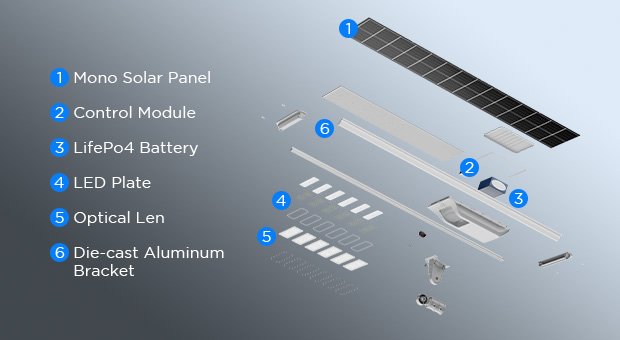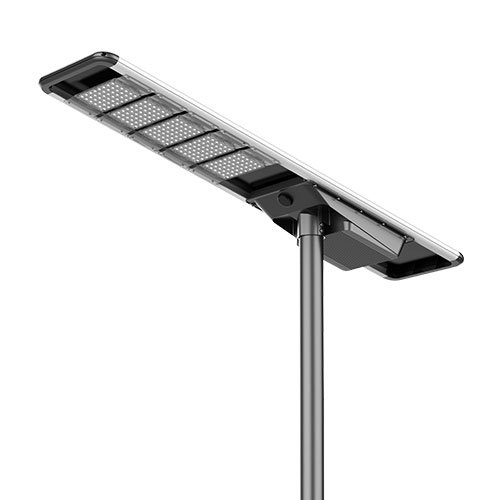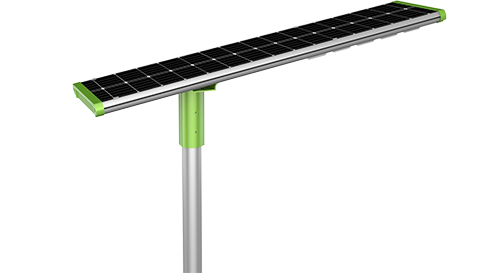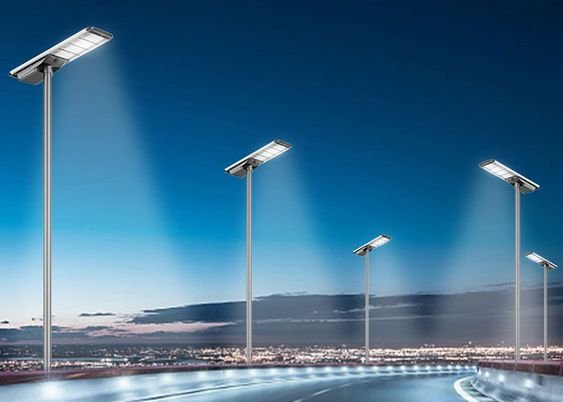Solar lighting has transformed public infrastructure in places where grid electricity is unreliable or costly. But now, there’s a new player in town: the all-in-one solution.
All-in-one solar street lighting is a self-contained, energy-efficient system that combines LED lighting, solar panels, batteries, and controllers into one unit—offering simple, reliable, and cost-effective outdoor illumination.
In this article, I’ll break down what all-in-one solar lights are, how they work, and why they’ve become a global favorite, especially in off-grid environments like rural Africa.
Why All-in-One Solar Street Light Technology Is Gaining Global Popularity?
Solar lighting has evolved from bulky setups to sleek, powerful all-in-one systems. And it’s not just a design trend—it’s solving real-world challenges.
All-in-one solar street lights integrate essential components into a compact unit, offering faster deployment, less maintenance, and optimal energy savings—making them ideal for urban and rural lighting.
From refugee camps in Uganda to newly built roads in Ghana, all-in-one systems have become the go-to solution for reliable and eco-friendly lighting. This article will help you understand why.
What Is an All-in-One Solar Street Light?

You’ve probably seen these sleek lights on a pole with no visible cables. That’s the power of integration.
An all-in-one solar street light is a self-contained outdoor lighting solution that combines a solar panel, LED lamp, rechargeable battery, and charge controller in a single housing.
Everything is neatly built into one unit, often mounted on a pole. The design eliminates complex installations and minimizes vulnerability to theft or vandalism.
Key Design Features
- Compact and Lightweight: Makes installation quick and easy
- Tamper-Resistant: No exposed wiring or loose parts
- Weatherproof Housing: Usually rated IP65 or higher
- Modern Look: Sleek profiles blend into urban and rural environments
It’s this simplicity and durability that make all-in-one lights perfect for African operators working with limited labor and tools.
How All-in-One Solar Street Light Works: Step-by-Step Function Overview
3.1 Daytime Charging Cycle of All-in-One Solar Street Light
During the day, the solar panel gets to work. It converts sunlight into energy and stores it.
The LED turns off automatically while the solar panel charges the battery using sunlight through photovoltaic conversion.
The controller plays a key role in this cycle. It prevents overcharging and ensures the battery is safely managed.
3.2 Nighttime Operation of All-in-One Solar Street Light
As night falls, sensors detect low ambient light levels.
The system auto-activates the LED light using stored battery energy, with preset dimming or brightness modes depending on motion detection or timer settings.
This cycle is fully automatic, so there’s no need for manual intervention or external wiring.
3.3 Smart Energy Management in All-in-One Solar Street Light
Efficiency matters. That’s where the MPPT controller steps in.
The Maximum Power Point Tracking (MPPT) controller optimizes power flow from panel to battery and manages lighting based on charge levels and usage demand.
By adjusting LED brightness or dimming when there’s no motion, the system conserves power and extends lighting duration.
Key Components of All-in-One Solar Street Light and Their Functions

4.1 Solar Panel in All-in-One Solar Street Light
Solar panels capture sunlight and convert it into electricity during the day.
Tips for Placement
- Face panels true north (in the Southern Hemisphere)
- Tilt angle: latitude + 10°
- Avoid shade from trees or buildings
We use monocrystalline panels in Huaweilight systems for better efficiency and longevity.
4.2 Lithium Battery in All-in-One Solar Street Light
The battery is your energy bank. It stores electricity for use at night.
Most all-in-one systems use lithium-ion or LiFePO4 batteries for better energy density and long service life.
Comparison Table
| Feature | Li-ion Battery | LiFePO4 Battery |
|---|---|---|
| Lifespan | 2–3 years | 5–7 years |
| Temp Tolerance | Medium | High |
| Safety | Moderate | Excellent |
In hot African climates, LiFePO4 offers better thermal stability.
4.3 LED Module in All-in-One Solar Street Light
LEDs are the light source, offering up to 200 lumens per watt with minimal heat generation.
Higher quality LEDs mean less energy consumption and longer life.
At Huaweilight, we only use Bridgelux or Philips chips for reliability.
4.4 MPPT Charge Controller in All-in-One Solar Street Light
The controller acts as the brain, balancing charging, discharging, and power delivery.
MPPT controllers extract maximum power from the panel even in cloudy or shaded conditions.
They also prevent:
- Overcharging during long summer days
- Overdischarging during long winter nights
4.5 Motion and Time Control Sensors in All-in-One Solar Street Light
These sensors enable adaptive brightness control to save power and extend runtime.
- Motion sensors: Light goes full brightness when motion is detected
- Timer settings: Light dims after peak hours to conserve energy
Such adaptive lighting is perfect for areas with low nighttime traffic.
4.6 Housing and Durability of All-in-One Solar Street Light
Housing is where everything comes together.
Most all-in-one lights feature IP65-rated, corrosion-resistant aluminum alloy housing.
Key benefits:
- Waterproof and Dustproof
- Anti-rust for coastal areas
- Impact-resistant design to prevent vandalism
Advantages of All-in-One Solar Street Light Over Traditional Solar Models

5.1 Installation Efficiency of All-in-One Solar Street Light
No trenching, cabling, or controller-mounting is needed—just mount the unit on a pole.
| Task | Traditional | All-in-One |
|---|---|---|
| Panel Mounting | Yes | Built-in |
| Battery Box Install | Yes | Built-in |
| Controller Wiring | Yes | Built-in |
| Pole Mount Only | No | Yes |
You save on labor, tools, and time.
5.2 Maintenance and Longevity of All-in-One Solar Street Light
All-in-one lights are plug-and-play with minimal failure points.
No cables mean fewer chances of theft or disconnection.
5.3 Energy Efficiency of All-in-One Solar Street Light
High-lumen LEDs and MPPT tech ensure maximum energy use from every sunray.
Zero electricity cost—your light runs fully off the sun.
5.4 Safety and Theft Protection in All-in-One Solar Street Light
Compact design reduces tampering risks and makes theft harder.
Ideal for installations in rural Africa where security concerns are real.
Comparison: Traditional vs All-in-One Solar Street Light
6.1 Lighting Source: LED vs HPS
| Feature | Traditional (HPS) | All-in-One (LED) |
|---|---|---|
| Lifespan | 5,000–10,000 hrs | 50,000+ hrs |
| Energy Use | High | Low |
| Warm-up Time | 5–10 mins | Instant |
6.2 Battery Technology
| Type | Traditional | All-in-One |
|---|---|---|
| Battery Location | Underground | Integrated |
| Maintenance | High | Low |
| Safety | Low | High |
6.3 Installation Process
| Step | Traditional | All-in-One |
|---|---|---|
| Trenching | Yes | No |
| Wiring | Yes | No |
| Assembly Time | Long | Short |
Use Cases: Where All-in-One Solar Street Light Works Best
- Rural Roads: No access to the grid, zero wiring needed
- Urban Parks: Quick deployment, less disruption
- Construction Sites: Temporary yet strong lighting
- Emergency Zones: Disaster relief or refugee areas

In Uganda, I’ve helped contractors install these lights in village clinics, border posts, and rural schools.
How to Choose the Right All-in-One Solar Street Light
8.1 Key Specifications to Look For
- Lumen Rating: 3,000–6,000 lm for general use
- Solar Panel Wattage: ≥40W for 30W LED
- Battery Capacity: At least 200Wh for 12-hour runtime
- Controller Type: MPPT preferred
8.2 Environmental Considerations
- Shade: Avoid trees and tall buildings
- Climate: Use LiFePO4 in hot or cold regions
- Orientation: Tilt and direction matter for charging
8.3 Installation Tips
- Mount at 4–6 meters height for residential roads
- Use anti-theft nuts for safety
- Clean panel monthly for best performance
Common Questions About All-in-One Solar Street Light
9.1 Can all-in-one solar street lights work in winter or cloudy regions?
Yes—with MPPT and oversized batteries, they can last 2–3 cloudy days.
9.2 How long do all-in-one solar street lights last?
5–7 years depending on component quality. LED chips can last up to 10 years.
9.3 How to maintain an all-in-one solar street light?
- Clean panel monthly
- Inspect battery and controller annually
- Reset dimming settings if needed
9.4 What brightness (lumens) do I need for my area?
- 2,000–3,000 lm for small paths
- 4,000–6,000 lm for roads
- 6,000+ lm for highways or large areas
9.5 Can all-in-one solar street lights be controlled remotely?
Yes, some models support remote control or mobile app via LoRa or Bluetooth.
Conclusion
All-in-one solar street lights combine smart design, simple installation, and reliable performance. They’re the future of outdoor lighting—especially where the grid can't reach.








